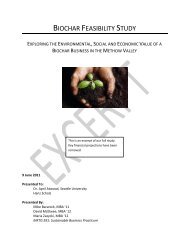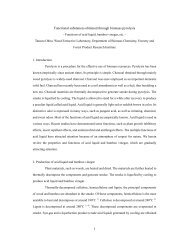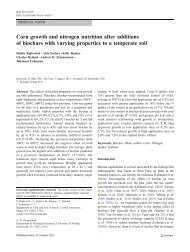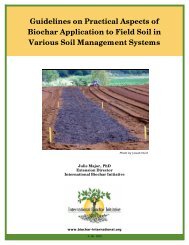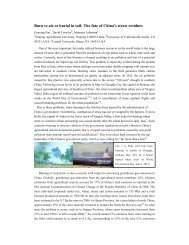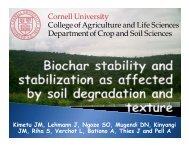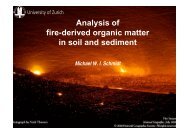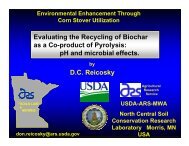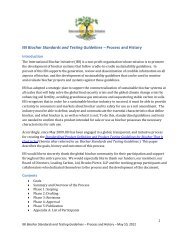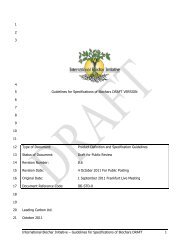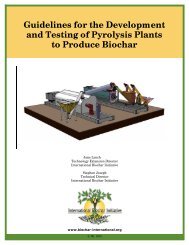Guidelines for Specifications of Biochars for Use in Soils FINAL ...
Guidelines for Specifications of Biochars for Use in Soils FINAL ...
Guidelines for Specifications of Biochars for Use in Soils FINAL ...
Create successful ePaper yourself
Turn your PDF publications into a flip-book with our unique Google optimized e-Paper software.
123456789101112131415161718192021222324252627282930313233343536372 Terms and Def<strong>in</strong>itionsNote: Terms and def<strong>in</strong>itions have been adapted from the references given. Terms anddef<strong>in</strong>itions created specifically <strong>for</strong> this document are referenced as “IBI”.Ash: The <strong>in</strong>organic matter, or m<strong>in</strong>eral residue <strong>of</strong> total solids, that rema<strong>in</strong>s when a sample iscombusted <strong>in</strong> the presence <strong>of</strong> excess air (US Compost Council and US Department <strong>of</strong>Agriculture 2001).Biochar: A solid material obta<strong>in</strong>ed from thermochemical conversion <strong>of</strong> biomass <strong>in</strong> an oxygenlimitedenvironment (IBI).Biochar Characteristics: For the purposes <strong>of</strong> these guidel<strong>in</strong>es, biochar characteristics are thosephysical or chemical properties <strong>of</strong> biochar that affect the follow<strong>in</strong>g uses <strong>for</strong> biochar: 1) biocharthat is added to soils with the <strong>in</strong>tention to improve soil functions; and 2) biochar that isproduced <strong>in</strong> order to reduce emissions from biomass that would otherwise naturally degrade toGHG, by convert<strong>in</strong>g a portion <strong>of</strong> that biomass <strong>in</strong>to a stable carbon fraction that has carbonsequestration value (IBI).Biological Material: Material derived from, or produced by, liv<strong>in</strong>g or recently liv<strong>in</strong>g organisms.This material can be ”unprocessed” or ”processed”. Unprocessed biological material is liv<strong>in</strong>gmaterial, or recently liv<strong>in</strong>g material from the plant k<strong>in</strong>gdom (or other non-animal taxa such asfungi or algae) that may have been mechanically resized (such as wood chips), but has notbeen processed <strong>in</strong> an animal’s body or gone through an anthropogenic chemical modification.Processed biological material is recently liv<strong>in</strong>g material that has been chemically modified byanthropogenic or biological processes (e.g., paper sludge, manure). All animal products,<strong>in</strong>clud<strong>in</strong>g bones, <strong>of</strong>fal, food-waste conta<strong>in</strong><strong>in</strong>g animal products, and animal manures areconsidered to be processed biological material (IBI).Biomass: The biodegradable fraction <strong>of</strong> products, waste and residues <strong>of</strong> biological orig<strong>in</strong> fromagriculture (<strong>in</strong>clud<strong>in</strong>g vegetal and animal substances), <strong>for</strong>estry, and related <strong>in</strong>dustries <strong>in</strong>clud<strong>in</strong>gfisheries and aquaculture, as well as the biodegradable fraction <strong>of</strong> <strong>in</strong>dustrial and municipalwaste (<strong>in</strong>clud<strong>in</strong>g municipal solid waste) (European Commission Agriculture and RuralDevelopment, 2010).Contam<strong>in</strong>ant: An undesirable material <strong>in</strong> a biochar material or biochar feedstock thatcompromises the quality or usefulness <strong>of</strong> the biochar or through its presence or concentrationcauses an adverse effect on the natural environment or impairs human use <strong>of</strong> the environment.(Adapted from Canadian Council <strong>of</strong> M<strong>in</strong>isters <strong>of</strong> the Environment 2005). Contam<strong>in</strong>ants <strong>in</strong>cludefossil fuels and fossil-fuel-derived chemical compounds, glass, and metal objects (IBI).Diluent/Dilutant: Inorganic material that is deliberately or <strong>in</strong>advertently com<strong>in</strong>gled with biomassfeedstock prior to process<strong>in</strong>g. These materials will not carbonize <strong>in</strong> an equivalent fashion to thebiomass. These materials <strong>in</strong>clude soils and common constituents <strong>of</strong> natural soils, such as claysand gravel that may be gathered with biomass or <strong>in</strong>termixed through prior use <strong>of</strong> the feedstockInternational Biochar Initiative – <strong>Guidel<strong>in</strong>es</strong> <strong>for</strong> <strong>Specifications</strong> <strong>of</strong> <strong>Biochars</strong> <strong>for</strong> <strong>Use</strong> <strong>in</strong> <strong>Soils</strong> 7



